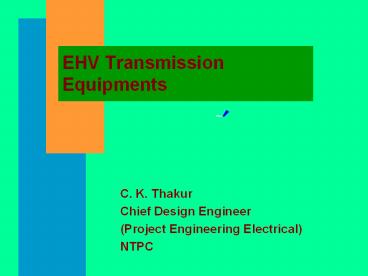EHV Transmission Equipments - PowerPoint PPT Presentation
Title:
EHV Transmission Equipments
Description:
Title: EHV Transmission Equipments Author: SPH03126 Last modified by: cmm Created Date: 4/24/2003 5:54:04 AM Document presentation format: On-screen Show – PowerPoint PPT presentation
Number of Views:885
Avg rating:3.0/5.0
Title: EHV Transmission Equipments
1
EHV Transmission Equipments
- C. K. Thakur
- Chief Design Engineer
- (Project Engineering Electrical)
- NTPC
2
Over view
- Switching Schemes.
- Type of Towers.
- Type of conductors.
- Switchyard types.
- Switchyard equipments.
- Switchyard Layouts.
3
Switching schemes
- Single bus.
- Main and Transfer (sectionalised).
- Double bus.
- One and half breaker scheme.
- Double main and Transfer (Sectionalised).
- Double Breaker
4
Factors Affecting Switching Scheme
- System Security/Reliability.
- - Feeder Fault.
- - Bus Fault.
- - Equipment Failure.
- - Redundancy.
5
Factors Affecting Switching Scheme (Contd.)
- Operational Flexibility.
- Ease of Maintenance.
- Simplicity of Protection Arrangements.
- Ease of Extension.
- Area available.
- Cost.
6
Line Towers
- Single Circuit.
- Double Circuit.
- Dead end type.
- Tension Towers.
- Suspension Towers.
7
Tower Design
- Wind Force.
- Conductor Tension.
- Span.
- Type of conductor.
8
Tower Hardwares
- Insulator Strings.
- Vibration Dampers.
- Spacers.
- Earthwire OPGW.
9
Type of Conductor
- ACSR Moose (800A).
- Zebra (700A).
- Rabbit (190A).
- Dog (290A).
10
Switchyard Type
- Conventional Air Insulated Type.
- Gas Insulated type.
- Air Insulated (Enclosed type).
11
Switchyard Equipments.
- Circuit Breaker.
- Disconnectors.
- Current Transformers.
- Capacitor Voltage Transformers.
- Lightning Arrestors.
- Post Insulators.
- Wave Traps
12
General Parameters
- Dielectric Parameters .(IEC 694)
- - Power Frequency Voltage.
- - Lightning Impulse Voltage.
- - Switching Impulse Voltage.
- - Corona Extinction Voltage.
- - RIV Level.
13
400kV Equipments
14
220kV Equipments
15
132kV Equipments
16
General Parameters (Contd.)
- Rated Current.
- Short Time Current.
- Creepage Distance.
17
Circuit Breakers Type
- MOCB.
- ABCB.
- SF6
18
Circuit Breaker
- Fault clearing.
- Load Make Break.
- Break Time.
- Single/Multi Break.
- Voltage Distribution across breaks.
- Closing resistors.
- Operating mechanism (Spring/Pneumatic/Hydraulic)
19
Disconnectors
- HCB Type.
- Double Break Type.
- Pantograph type.
- Vertical Break type.
- Provision of Earth Switches.
- Motor / Pneumatic operated.
- Gang operated/Single pole type.
20
Current Transformer
- Bar Primary type.
- Dead tank/Live tank type.
- Ring Type.
- No. of Cores.
- Ratio.
- Accuracy.
21
Capacitor Voltage Transformer
- Capacitance.
- Voltage Ratio.
- No. Of Cores.
- Accuracy.
22
Lightning Arrestor
- Gap Type / Gapless Type.
- Voltage Rating.
- Energy Capability.
- Monitoring.
- Location.
23
Post Insulators
- Voltage Rating.
- Cantilever Strength.
- Fixing Details.
24
Wave Trap
- Rated Inductance(0.5/1.0 mH).
- Rated current.
- Band Width.
- Coupling (Phase to Phase).
25
Switchyard Layout Guidelines
- Place All Equpt. At ground level for ease of
maintenance. - Busbars placed at right angles to feeders.
- Accessibility of feeders from either side of
switchyard. - Conductor crossings at right angles be separated
to achieve adequate clearances.
26
Switchyard Layout Guidelines(Contd.)
- For 400kV - Phase to Phase 4000 mm - Phase to
earth 3500mm - For 220kV
- - Phase to Phase 2100 mm
- - Phase to earth 2100mm
27
Switchyard Layout Guidelines(Contd.)
- Lower level connections can be of Rigid pipe or
flexible conductor. - Upper level connections can be of strung type
only. - For aesthetic looks and similarity all same
equipments be in one line as far as possible. - Road near circuit breaker be kept for maintenance
purpose.
28
Switchyard Layout Guidelines(Contd.)
- Provide Double insulator strings for upper level
for safety reasons and to avoid busfaults due to
conductor snapping. - Cable trenches to be routed for ease in
maintenance and movement. - Lightning protection to be provided using
Lightning masts and/or shield wires. - Lighting to be provided by fixtures on LM
platform.
29
(No Transcript)

